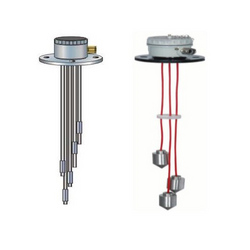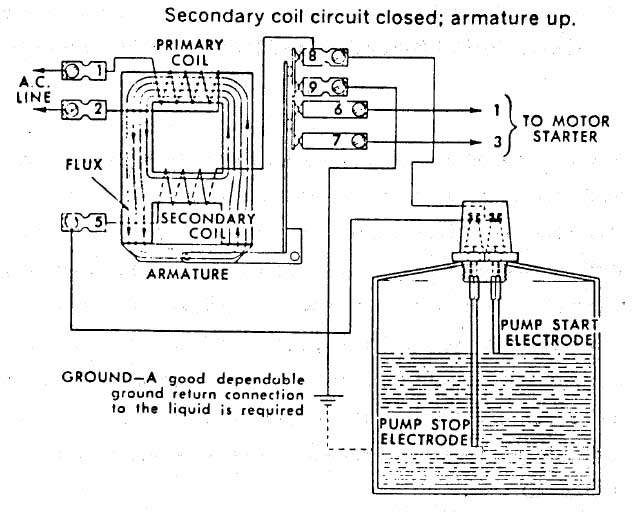Conductance type: Indirect level measurement
As the name implies, conductivity level switches operate on the principle of electrical conductivity.
Electrodes located within containers at the point of control make or break contact with the conductive material, thus completing an electrical circuit which operates load contacts for pumps and solenoid valves or performs other control or alarm functions.
The schematic of a heavy-duty switch of this type is shown in figure below. When a source of alternating current is connected to the primary coil, a magnetic flux is set up which induces a voltage in the secondary coil. Current flows in the secondary coil however, only when the rising liquid completes the circuit between the two electrodes. Completion of the secondary coil circuit and the resultant current flow sets up a bucking action in the lower bar of the transformer core. This tends to divert lines of magnetic flux to the core legs and sets up an attraction that moves the armature, closing or opening load contacts.

One pair of contacts connect the secondary circuit to ground when liquid contacts the upper electrode and acts as a holding circuit to maintain the relay in its closed position until the liquid falls below the lower electrode. This holding circuit provides control of the load circuit through the bottom contacts of the relay over any desired range in the liquid level, depending upon the distance between the upper and lower electrodes.
The flow of current through the low energy secondary circuit is very small and varies with the voltage of the secondary coil. The secondary coil is selected to operate over the resistance of the liquid being controlled.
The two-electrode system shown operates a pump to maintain a desired level in a vessel -from a simple on-off action where one electrode and the container complete a circuit via the conductive material to multi-electrode assembly where several switch actions occur at various container levels.
Conductivity switches are economical and have no moving parts in contact with the measure material. Early, heavy-duty designs were used primarily on water applications because of the high energy levels which could result in sparking to produce fires or explosions. However, manufacturers now offer solid-state designs, operating at low energy levels, which can be considered intrinsically safe.

